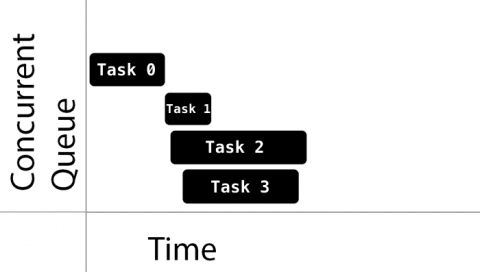- Concurrency는 structure에 관한 것인 반면 parallelism은
- 멀티 코어 디바이스에서 사용합니다.
- 여러개의 thread를 "동시"에 수행합니다.
- 반면, 멀티 코어 디바이스는 parallelism 를 통하여 여러개의 thread를 동시에 시수행합니다.
- 싱글 코어 디바이스에서 사용합니다.
- Time Slicing 을 이용하여
- 하나의 Thread를 수행하고
- Context Switch를 실행 후
- 또다른 Thread를 수행합니다.
-
작업 단위를 queue에 전송하면 GCD는 FIFO(First in, First out) 순으로 작업을 실행합니다.
-
GCD는 concurrency library로 multi-thread 코드를 작성할 수 있게 도와줍니다.
-
Dispatch queue는 thread safe 합니다.
-
즉, 여러 thread들이 동시에 dispatch queue에 접근할 수 있습니다.
-
Dispatch queue 에 code 블럭 혹은 work item을 추가할 수 있고, 어떠한 thread에서 이것들을 실행할 것인지를 결정합니다.
-
시스템과 이용가능한 시스템 리소스를 기반으로 하여 얼마나 많은 parallelism이 필요한지 결정합니다.
- Parallelism은 concurrency를 필요로합니다.
- 하지만, concurrency는 parallelism을 보장하진 않습니다.
- 주어진 시간에 대하여 오직 하나의 task만이 실행됩니다.
- 동일한 시간에 여러개의 task를 실행할 수 있습니다.
- FIFO순으로 실행하기 때문에, task를 추가한 순서대로 시작하도록 보장됩니다.
- 단, task의 종료에 대한 순서는 알 수 없습니다.
- Main thread에서 실행됩니다.
- Serail Queue입니다.
- UI에 대한 모든 것을 전담합니다.
- 전체 시스템에서 공유하는 Concurrent Queue 입니다.
- User-Interactive
- User-Initiated
- Utility
- Background
Asynchronous
Dispatch queue에 다중의 작업 항목들을 넣고 다시 dispatch하면, 해당 작업을 수행할 thread 를 불러옵니다.
Dispatch는 작업 항목을 queue에서 꺼내와 수행합니다. Queue에 존재하는 모든 작업 항목을 끝마쳤을 때, 시스템은 사용했던 thread를 도로 가져갑니다.

Synchronous
자신만의 Thread를 가지고 있고, 그 thread는 해당 queue에서 코드를 실행하고 그것이 일어날 때까지 기다리고 싶어합니다. 해당 작업을 발송 대기열에 제출할 수 있지만 그 작업이 차단됩니다. 실행을 요청한 항목이 완료 될 때까지 기다립니다.
이 queue에 asynchronous 작업을 더 추가할 수 있습니다. 그리고 dsipatch는 queue에 잇는 항목들을 서비스하기 위하여 thread를 불러옵니다.
Asynchronous 작업을 수행하다가 synchronous 작업을 수행해야할 시점이 오면, dispatch queue는 대기 중인 thread로 제어권을 전달하고 항목을 실행한 후 dispatch queue의 제어권은 dispatch에 의하여 제어되는 worker thread로 돌아갑니다.
디스패치 대기열은 대기중인 스레드로 제어를 전달하고 해당 항목을 실행 한 다음 디스패치 대기열을 제어하여 디스패치로 제어되는 작업자 스레드로 다시 되돌아갑니다.

Syncronous
Subsystem 사이의 serialize state를 위하여 synchronous 실행을 사용할 수 있습니다. Serial queue와 dispatch queue들은 자연적으로 연속적(serial)입니다. 그리고 이것을 mutual exclusion property로 사용할 수 있습니다.
var count: Int {
queue.sync { self.connections.count }
}deadlock을 발생시킬 수 있으니 주의해야합니다.

global 변수는 atomic하게 초기화 됩니다. 하지만 클래스 property와 lazy property는 atomic 하지 않습니다.
"There is no such thing as a benign race."
Synchronization 포인트를 잊는 다면, 크래쉬를 일으키거나 유저의 데이터를 손상시킬 수 있습니다.
class Foo {
private let internalState: Int
private let internalQueue: DispatchQueue
var state: Int {
get {
return internalQueue.sync { internalState }
}
set {
internalQueue.sync { internalState = newState }
}
}
}https://www.raywenderlich.com/5370-grand-central-dispatch-tutorial-for-swift-4-part-1-2


